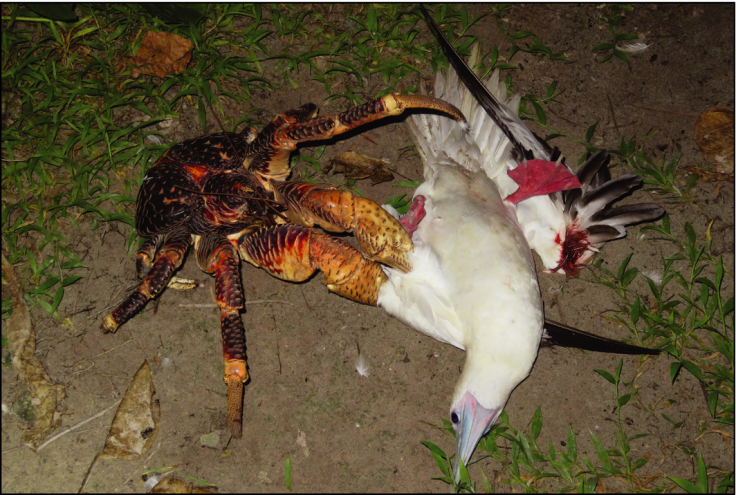Watch: Giant Coconut Crab Savagely Kills, Eats Large Bird

An enormous land-dwelling crab that is known for climbing trees and cracking open coconuts with its huge pincers will also attack and eat birds — and watching it happen can be heart-wrenching.
The new information about coconut crab diets and predatory habits comes from an article in the journal Frontiers in Ecology and the Environment, after a biologist saw one of the crustaceans kill and consume an adult red-footed booby. The images and narrative of the event are not for the faint of heart, as the graphic account and visuals depict exactly the type of brutal and merciless attack that is natural in the wild but still makes compassionate humans wince or even get choked up.
“The booby had been sleeping on a low-lying branch, less than a meter up the tree,” the paper says. “The crab slowly climbed up and grabbed the booby’s wing with its claw, breaking the bone and causing the booby to fall to the ground, where it was unable to fly. The crab then approached the bird, grabbing and breaking its other wing. The booby struggled and pecked at the crab, but the crab retained its grip with both claws, kicking at the bird with its ambulatory legs.”
It only gets worse for the bird as other crabs appear on the scene.
“Five more coconut crabs came to the site within 20 minutes, likely cueing in on the blood with their neurologically acute olfactory sense. The attacker responded by dragging the booby several meters away, and then released its grip. As the booby lay paralyzed, the crabs fought, eventually tearing the bird apart over several hours, carrying it away, and consuming it.”
This happened in the Chagos Archipelago at the heart of the Indian Ocean. Also on that island chain, the scientist had looked at a crab’s burrow around the same time and found a red-footed booby’s dead body.
That bird is one of the largest that can be found at Chagos.
Coconut crabs are also known as robber crabs, and are nocturnal creatures that can be found around the Indian Ocean as well as the southwestern Pacific. They can grow to about 3.5 feet across and weigh up to 10 pounds. Their pincers can exert more than 700 pounds of force.
The paper explains that the coconut crab, scientific name Birgus latro, is “the world’s largest terrestrial invertebrate, growing to what Charles Darwin described as ‘a monstrous size.’”
These crustaceans have experienced population declines due to conflict with humans, although they are not well-understood and human interference could be influencing their behavior. At Chagos, the crabs are mostly left alone and display more natural behavior, according to the article.
Crabs can be either carnivores or omnivores, but are known as scavengers. To observe a coconut crab attacking and killing a large bird represents newly identified behavior, although others have seen rare attacks before.
The paper says that the observation has implications for understanding birds and other potential prey, not just coconut crabs, because animals could change their behavior in response to predation. For example, birds that nest on the ground may be more likely in areas where their eggs are not at risk of coconut crab attacks.
© Copyright IBTimes 2025. All rights reserved.





















